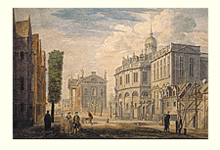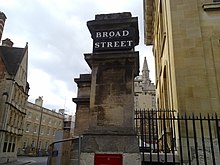Broad Street, Oxford

Broad Streetis a wide street in centralOxford,England,just north of the former city wall.[1][2] The street is known for itsbookshops,including the originalBlackwell'sbookshop at number 50, located here due to theUniversity of Oxford.Among residents, the street is traditionally known asThe Broad[citation needed].
Location
[edit]
In Broad Street areBalliol College,Trinity College,Exeter College(front entrance in the adjoiningTurl Street).[3][4]TheMuseum of the History of Science(in the originalAshmolean Museumbuilding), theClarendon Building,theSheldonian Theatreand theWeston Library(renamed in 2015, part of theBodleian Library,the main University library in Oxford) are important historicalOxford Universitybuildings at the eastern end of the street. These buildings form thede factocentre of the University, since most academic buildings in the centre of Oxford are owned by individual (and autonomous) colleges rather than the University itself.
To the west, the street becomesGeorge Street.The junction with George Street is a crossroads withMagdalen Streetto the north andCornmarket Streetto the south. To the east, the street becomesHolywell Street.The junction with Holywell Street is another crossroads, withParks Roadto the north andCatte Streetto the south. TheIndian Institute(nowThe James Martin 21st Century School), designed byBasil Champneys,is on the corner of Catte Street and Holywell Street, but faces Broad Street and visually forms its end.[5]
History
[edit]

The street developed alongside the town ditch in front of thecity wall[broken anchor],which was built in AD 911.[6]It is a wide street, formerly called Horsemonger Street[7]because it was Oxford's horse market. The street's one remaining pub, a 16th or 17th-century timber-framed building next to Blackwell's bookshop, is appropriately called the White Horse.[8]
On Broad Street, the ProtestantOxford Martyrs,Hugh LatimerandNicholas Ridley(16 October 1555), and laterThomas Cranmer(21 March 1556), were burnt at the stake just outside the city wall.[6]A cross ofgranitesettsin the road oppositeBalliol Collegemarks the location. Nearby inSt Giles',the events are commemorated with aGothic Revivalstone monument, theMartyrs' Memorial.
The city walls were rebuilt in localcoral ragstonein 1226–40.[4]By the 16th or 17th century, improvedartilleryhad made the walls obsolete, so the city divided the town ditch on the south side of Broad Street into a row ofburgageplots, on which buyers built houses and later shops. Most of the wall beside Broad Street was dismantled to reuse its stone, but onebastionsurvives behind number 6.[9]
TheSheldonian Theatre,set back from Broad Street behind a stone wall, iron railings and stone pillars with a set of stone heads (traditionallyRoman emperors), was built in 1664–68 to a design by SirChristopher Wrenfor theUniversity of Oxford.
TheOld Ashmolean Buildingwas built in 1683 to houseElias Ashmole's collection. It was the world's first museum to open to the public. In 1845, theAshmolean Museummoved toBeaumont Streetand the original Ashmolean building became offices for theOxford English Dictionary.Since 1924, the building has housed the Museum of the History of Science.
TheClarendon Buildingwas built 1711–15 to house theOxford University Press's printing operations. It was designed byNicholas Hawksmoor,a pupil of Wren.
The academic and physicianHenry Acland(1815–1900) lived in the street at number 40 on the site of theWeston Library,part of Oxford University'sBodleian Library.His daughterSarah Angelina Acland(1849–1930), a pioneer of colour photography, was born here.[10]
Shops
[edit]
Boswells,the largest independentdepartment storein Oxford, was established in 1738, and traded at the same location on the south side of Broad Street opposite Balliol College until its closure in 2020.Thornton's Bookshop,also on the south side of the street at number 11, was founded byJoseph Thornton(1808–91) in 1835 and closed at the end of 2002.

The pioneer photographerHenry Taunt(1842–1922) had a shop and studio at 9–10 Broad Street, moving here fromCornmarket Streetin 1874. He also established apicture-framingbusiness in Boxall's Yard, behind the premises. The lease expired in 1894 and he was forced to file for bankruptcy.[11]
Blackwell'sbookshop, on the north side of the street, was founded byBenjamin Henry Blackwell,the son of the first city librarian, in 1879. The shop was initially only 12 feet square, but quickly grew to include space upstairs, in the cellar, and neighbouring shops.[12]It is now Oxford's leading bookshop, with other specialist branches elsewhere in Broad Street and Oxford.
During 1894–1923, theHolywell Presshad its premises and bookshop at 29 Broad Street in the formerChapel of St Mary at Smith Gate.[13]In 1923, the building became part ofHertford Collegeand is now formally at the northern end of the adjoiningCatte Street.
The firstOxfamcharity shopand office were established byCecil Jackson-Cole(1901–79) at 17 Broad Street in 1947. It is still an Oxfam shop, and in 2002 theOxfordshire Blue Plaques Boardunveiled ablue plaqueon its outside wall.[14]
References
[edit]- ^Jenkins, Stephanie."Broad Street".Oxford History.
- ^Sherwood & Pevsner 1974,pp. 312–313.
- ^Sherwood & Pevsner 1974,p. 71.
- ^abTyack 1998,p. 22.
- ^Sherwood & Pevsner 1974,p. 263.
- ^abJenkins, Stephanie."Landmarks in the History of Broad Street".Oxford History.Retrieved3 August2012.
- ^Tyack 1998,p. 3.
- ^Historic England."The White Horse public house (Grade II) (1185470)".National Heritage List for England.Retrieved29 March2018.
- ^Historic England."Bastion 4 Bastion Number 4 (Grade I) (1184408)".National Heritage List for England.Retrieved29 March2018.
- ^Hudson 2012,p. 7.
- ^Graham 1973,2. His character.
- ^"Discover Blackwell's: The History and Heritage of an Oxford Family Bookshop".Blackwell's.Retrieved12 January2023.
- ^"No. 29: Former Octagonal Chapel".Broad Street, Oxford.UK: Oxford History.Retrieved12 January2023.
- ^"Cecil Jackson-Cole (1901–1979)".Oxfordshire Blue Plaques Scheme.Oxfordshire Blue Plaques Board.Retrieved29 March2018.
Bibliography
[edit]- Graham, Malcolm (1973). "2. His character".Henry Taunt of Oxford: A Victorian Photographer.Headington:Oxford Illustrated Press.ISBN0-902280-14-7.
- Hudson, Giles (2012). "Chronology".Sarah Angelina Acland: First Lady of Colour Photography.Oxford:Bodleian Library,University of Oxford.p. 7.ISBN978-1-85124-372-3.
- Sherwood, Jennifer;Pevsner, Nikolaus(1974).Oxfordshire.The Buildings of England.Harmondsworth:Penguin Books.pp. 71, 100, 134, 137, 138, 203, 254, 263, 312, 313.ISBN0-14-071045-0.
- Tyack, Geoffrey (1998).Oxford An Architectural Guide.Oxford & New York:Oxford University Press.pp. 22, 35, 51, 54, 116, 117, 119, 126, 128, 151, 182, 210, 223, 228, 253, 256, 263, 292, 325.ISBN0-19-817423-3.
External links
[edit] Media related toBroad Street, Oxfordat Wikimedia Commons
Media related toBroad Street, Oxfordat Wikimedia Commons
